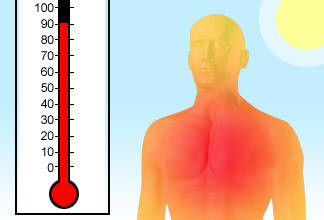|
| |
    

Your body builds up heat when you work and sweats to get rid of extra heat.
But sometimes your body may not cool off fast enough. This can happen, say, if
you are up on a roof pouring hot asphalt or you are lifting heavy loads.
Too much heat can make you tired, hurt your job performance, and increase your
chance of injury. You can get skin rash. You can also get:
 | Dehydration. When your body loses water, you can't cool off fast
enough. You feel thirsty and weak. |
 | Cramps. You can get muscle cramps from the heat even after you
leave work. |
 | Heat exhaustion. You feel tired, nauseous, headachy, and giddy
(dizzy and silly). Your skin is damp and looks muddy or flushed. You may
faint. |
 | Heat stroke. You may have hot dry skin and a high temperature, Or
you may feel confused. You may have convulsions or become unconscious. Heat
stroke can kill you unless you get emergency medical help. |
The Risk of Heat Stress:
Your risk of heat stress depends on many things. These include:
 | Your physical condition |
 | The weather (temperature, humidity) |
 | How much clothing you have on. |
 | How fast you must move or how much weight you must lift. |
 | If you are near a fan or there is a breeze |
 | If you are in the sun. |
If there is an industrial hygienist on your work site, ask the hygienist about
the Wet-Bulb Globe Temperature Index. It is a more precise way to estimate the
risk of heat stress.
Protect Yourself
Try to do these things:
 | Drink a lot of cool water all day. Sometimes, you may need a cup of
water (5 to 7 ounces) every 15 minutes. |
 | Keep taking rest breaks. Rest in a cool, shady spot. Use fans. |
 | Wear light-colored clothing made of cotton. |
 | Do the heaviest work in the coolest time of the day. |
 | Work in the shade. For heavy work in hot areas, take turns with
other workers, so some can rest. |
 | If you travel to a warm area for a new job, you need time for your
body to get used to the heat. Be extra careful the first 2 weeks on the job.
|
 | If you work in protective clothing, you need more rest breaks. You
may also need to check your temperature and heart rate. On a Superfund site
where the temperature is 70 degrees or more, the U.S. Environmental Protection
Agency (EPA) says a health professional should monitor your body weight,
temperature, and heart rate. |
If you think someone has heat stroke, immediately move the victim
to the shade. Loosen his/her clothes. Wipe or spray his/her skin with cool water
and fan him/her. You can use a piece of cardboard or other material as a fan.
| |
|